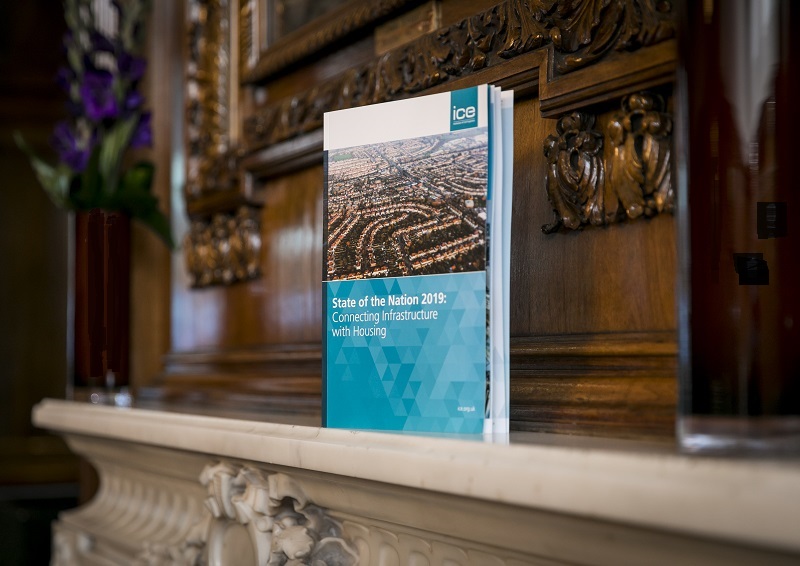ICE State of the Nation report 2019 - connecting infrastructure with housing

|
| In September 2019, the ICE published its annual State of the Nation report (Connecting Infrastructure with Housing) which focused on the steps required to better integrate the delivery of infrastructure and housing. Photo: Visual Eye |
Contents |
[edit] Introduction
Civil engineering exists to improve our quality of life – and the role of our homes in our quality of life cannot be disputed. The provision of housing, as part of creating high-quality, productive places, is one of the UK’s most pressing problems. So, the decision to focus our key policy report on the need for a more integrated approach to the way housing is delivered alongside infrastructure is entirely intentional.
We cannot afford to have swathes of new developments served by poor infrastructure connections and public services, nor do we want to see a lack of strategic or local infrastructure causing a block to quality sites. We want to be a part of the creation of strong, productive and sustainable places for the people who live in them for generations to come.
This report, State of the Nation 2019: Connecting Infrastructure with Housing report identifies that more of the same will not suffice.
[edit] Identifying the issues
In producing State of the Nation (SoN), we spoke to 170 expert individuals and organisations across the UK for their views on current challenges and where improvements can be made. These included housebuilders, strategic landowners, local and national public bodies, and many others.
The themes and challenges that were discussed time and again included: disjointed approaches to the phasing of infrastructure and housing, inequitable funding models and a lack of co-ordination between plans and strategies at different levels, even where they are adjacent.
We have two new drivers at our disposal that make the 2019 State of the Nation report both timely and topical:
- A public desire and demand for solutions that take much better account of climate change.
- New technologies and their potential to plan, deliver and operate differently.
We know that we can do much more to deliver homes and infrastructure with the climate-led net-zero carbon agenda in mind, and we can see the broad directions of technological travel across the transport, energy, water and digital sectors, noting their continued evolution.
We will only achieve our UK policy target of achieving net zero by 2050 through future-proofed solutions that harness and bind together the need to tackle climate change and the opportunity offered by technology.
As civil engineers, we have a phenomenal opportunity, right now, to shape and change the world in a visible, relevant and responsible way that delivers real results.
We do not need all the answers up front to know that every sector can and must do more. We are all on this hook together: we need better design, much better delivery and long-run operational changes to our systems and networks, whether new or existing.
This applies as much to heating systems in homes to the emergence of increasingly connected and automated vehicles, from renewable and decentralised energy sources to low-carbon construction.
So, what solutions have we identified?
[edit] Solutions for better connecting infrastructure and housing
To improve the way in which infrastructure and housing are planned, the report sets out the case for regional infrastructure strategies to be developed. Such strategies could be developed by widening the remit of the current - and potential future - sub-national transport bodies to include all economic infrastructure sectors.
Each strategy would identify the provision of infrastructure and housing required in a given region, while taking into consideration the priorities set out in the government’s forthcoming National Infrastructure Strategy to ensure that joined-up planning takes place at regional and national scales.
Reforms to the Development Consent Order regime are put forward in the planning section of the report. If adopted, these would enable developments of 5,000 or more homes to be delivered with the necessary infrastructure to support them under one consent.
On funding, the case for extending the Housing and Infrastructure Fund beyond 2023-24 is made, including proposals for ringfencing part of the money available in order to unlock development in areas of England with lower land values.
Finally, the report also calls for housing to be added to the National Infrastructure Commission’s charter and recommends that its next infrastructure assessment should identify options for futureproofing developments in order to help inform new housing standards in England. This would help to ensure that infrastructure and housing delivery takes proper account of our net-zero objectives and the associated advances in technology that are required to achieve them.
[edit] About this article
This article was written by Rachel Skinner, Vice President Public Voice. It was previously published on the ICE website and can be accessed here.
[edit] Related articles on Designing Buildings
- Achieving sustainable roads funding in England.
- Articles by ICE on Designing Buildings Wiki.
- Cyber security and engineering.
- Data and infrastructure productivity.
- Digital Built Britain.
- Digital communications and infrastructure dependencies.
- Digital technology.
- Digital transformation - engineers need to keep pace.
- How can we help achieve net zero?
- How to gain a competitive edge with digital technologies.
- How to make the digital revolution a success.
- Ripe for transformation, ready for change?
- State of the nation: Devolution.
- State of the nation: Digital transformation.
- State of the Nation 2018: Infrastructure Investment
- State of the Nation 2020.
- The future of the planning system in England.
Featured articles and news
RTPI leader to become new CIOB Chief Executive Officer
Dr Victoria Hills MRTPI, FICE to take over after Caroline Gumble’s departure.
Social and affordable housing, a long term plan for delivery
The “Delivering a Decade of Renewal for Social and Affordable Housing” strategy sets out future path.
A change to adoptive architecture
Effects of global weather warming on architectural detailing, material choice and human interaction.
The proposed publicly owned and backed subsidiary of Homes England, to facilitate new homes.
How big is the problem and what can we do to mitigate the effects?
Overheating guidance and tools for building designers
A number of cool guides to help with the heat.
The UK's Modern Industrial Strategy: A 10 year plan
Previous consultation criticism, current key elements and general support with some persisting reservations.
Building Safety Regulator reforms
New roles, new staff and a new fast track service pave the way for a single construction regulator.
Architectural Technologist CPDs and Communications
CIAT CPD… and how you can do it!
Cooling centres and cool spaces
Managing extreme heat in cities by directing the public to places for heat stress relief and water sources.
Winter gardens: A brief history and warm variations
Extending the season with glass in different forms and terms.
Restoring Great Yarmouth's Winter Gardens
Transforming one of the least sustainable constructions imaginable.
Construction Skills Mission Board launch sector drive
Newly formed government and industry collaboration set strategy for recruiting an additional 100,000 construction workers a year.
New Architects Code comes into effect in September 2025
ARB Architects Code of Conduct and Practice available with ongoing consultation regarding guidance.
Welsh Skills Body (Medr) launches ambitious plan
The new skills body brings together funding and regulation of tertiary education and research for the devolved nation.
Paul Gandy FCIOB announced as next CIOB President
Former Tilbury Douglas CEO takes helm.
UK Infrastructure: A 10 Year Strategy. In brief with reactions
With the National Infrastructure and Service Transformation Authority (NISTA).























